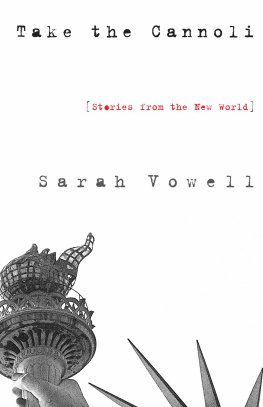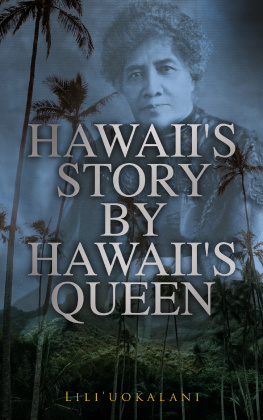Table of Contents
ALSO BY SARAH VOWELL
The Wordy Shipmates
Assassination Vacation
The Partly Cloudy Patriot
Take the Cannoli
Radio On
RIVERHEAD BOOKS
Published by the Penguin Group
Penguin Group (USA) Inc., 375 Hudson Street, New York, New York 10014, USA Penguin Group (Canada), 90 Eglinton Avenue East, Suite 700, Toronto, Ontario M4P 2Y3, Canada (a division of Pearson Penguin Canada Inc.) Penguin Books Ltd, 80 Strand, London WC2R oRL, England Penguin Ireland, 25 St Stephens Green, Dublin 2, Ireland (a division of Penguin Books Ltd) Penguin Group (Australia), 250 Camberwell Road, Camberwell, Victoria 3124, Australia (a division of Pearson Australia Group Pty Ltd) Penguin Books India Pvt Ltd, 11 Community Centre, Panchsheel Park, New Delhi-110 017, India Penguin Group (NZ), 67 Apollo Drive, Rosedale, North Shore 0632, New Zealand (a division of Pearson New Zealand Ltd) Penguin Books (South Africa) (Pty) Ltd, 24 Sturdee Avenue, Rosebank, Johannesburg 2196, South Africa
Penguin Books Ltd, Registered Offices: 80 Strand, London WC2R oRL, England
Copyright 2011 by Sarah Vowell
All rights reserved. No part of this book may be reproduced, scanned, or distributed in any printed or electronic form without permission. Please do not participate in or encourage piracy of copyrighted materials in violation of the authors rights. Purchase only authorized editions.
Published simultaneously in Canada
Library of Congress Cataloging-in-Publication Data
Vowell, Sarah, date.
Unfamiliar fishes / Sarah Vowell.
p. cm.
Includes bibliographical references.
eISBN : 978-1-101-48645-0
1. HawaiiHistory. 2. HawaiiAnnexation to the United States. 3. Hawaii
Colonization. 4. AmericanizationHistory. 5. ImperialismHistory. 6. United States
Territorial expansion. 7. United StatesForeign relations1897-1901. I. Title.
DU625.V
996.9dc22
Ward
While the author has made every effort to provide accurate telephone numbers and Internet addresses at the time of publication, neither the publisher nor the author assumes any responsibility for errors, or for changes that occur after publication. Further, the publisher does not have any control over and does not assume any responsibility for author or third-party websites or their content.
http://us.penguingroup.com
TO OWEN
A NOTE ON THE TEXT
While I have retained some Hawaiian diacritical marks I believe English readers will find helpful in navigating oceans of vowels, in Nahienaena for instance, I have dispensed with them in other words common in English usage or Hawaiian history, referring to the state that is the books subject as Hawaii rather than Hawaii, or the residence of the Kalakaua dynasty as Iolani Palace rather than Iolani, or the last Hawaiian queen as Liliuokalani rather than Liliuokalani, etc.
The land we live in seems to be strong and active. But how fares the land that lives in us?
GROVER CLEVELAND, Patriotism and Holiday Observance
In the morning there was a big wind blowing and the waves were running high up on the beach and he was awake a long time before he remembered that his heart was broken.
ERNEST HEMINGWAY, Ten Indians
UNFAMILIAR FISHES
W hy is there a glop of macaroni salad next to the Japanese chicken in my plate lunch? Because the ship Thaddeus left Boston Harbor with the first boatload of New England missionaries bound for Hawaii in 1819. That and its Saturday. Rainbow Drive-In only serves shoyu chicken four days a week.
A banyan tree in Waikiki is a fine spot for a sunburned tourist from New York City to sit beneath and ponder the historical implications of a lukewarm box of takeout. Because none of us belong herenot me, not the macaroni, not the chicken soaked in soy sauce, not even the tree.
Like a lot of people and things in these islands, banyans are imports from somewhere else. In this case, India. The banyans gray branches shoot off slim sprouts that drip down and bore slowly into the ground and take root, bulging into new, connected trunks so as to support more and more tendrils, leading to more and more trunks, until each tree becomes its own spooky little forest.
There is a banyan shading Courthouse Square in the town of Lahaina, on Maui, that was planted in 1873 to commemorate the fiftieth anniversary of the arrival of New England missionaries on that island. It was eight feet tall when a missionary descendant planted it, and now it stands over sixty feet high, with twelve trunks spanning more than two hundred square feet.
One time I was in the Lahaina courthouse chatting with a woman who worked there about the banyan. She told me that the town gardeners put a lot of effort into confining that tree within the square because otherwise it would keep on growing until its roots and branches cracked the foundations and punctured the walls of all the nearby buildings, finally toppling everything in its path. In fact, the banyans tendency to crowd out and destroy its neighbors has earned it the pet name strangler fig.
Here in Waikiki, the U.S. Army Museum is hunkered down in the midst of all the concrete high-rise hotels and condominiums built in the post-1959 statehood architectural style I like to think of as A Very Brady Brutalism. The park where my plate lunch and I are sitting appears in an old black-and-white photograph on display there. The picture was taken in the summer of 1898, a few days after the sons of missionaries who had dethroned the Hawaiian queen handed over Hawaii to the United States. The park is pitched with the tents of the First New York Voluntary Infantry. The Spanish-American War had the soldiers stopping off in this suddenly American city en route to the Philippines to persuade the Filipino people at gunpoint that self-government really isnt for everyone. They named their encampment after the president who dispatched them here: Camp McKinley.
The United States declared war on Spain in April of 1898. By August, the McKinley administration had invaded the Spanish colonies of Cuba, Puerto Rico, the Philippines, and Guam and annexed Hawaii. In this four-month orgy of imperialism, the United States became a world power for the first timebecame what it is now.
Hurrah for Hawaii! Theodore Roosevelt wrote from Cuba when he heard the news that the U.S. annexed the islands. He was in the Caribbean with the Rough Riders, licking the Spanish at Santiago de Cuba. One of the end results of that conquest was American control of Guantnamo Bay. To Roosevelt and his likeminded cronies in the government and military, the most important objective of all the 1898 maneuvers was possession of far-flung islands for naval bases at strategic ports like Guantanmo and Honolulus Pearl Harbor. He and his friends had pined for these bases for years the way a normal man envisions his dream house. All they ever wanted was a cozy little global empire with a few islands here and there to park a fleet of battleships.















